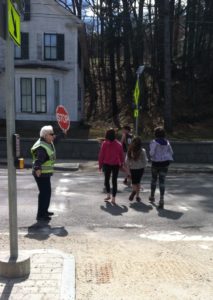What is Safe Routes to School?
Safe Routes to School (SRTS) is a movement to encourage students, including those with disabilities, to safely walk, ride bicycles, or use other forms of active transportation to and from school. Funded by the U.S. Department of Transportation, SRTS aims to improve safety for children who walk or bike to school, decrease rates of childhood obesity and related diseases, and ease traffic congestion and improve air quality near schools.
(SRTS) is a movement to encourage students, including those with disabilities, to safely walk, ride bicycles, or use other forms of active transportation to and from school. Funded by the U.S. Department of Transportation, SRTS aims to improve safety for children who walk or bike to school, decrease rates of childhood obesity and related diseases, and ease traffic congestion and improve air quality near schools.
Safe Routes to School (SRTS) programs use the framework of the 5 Es:
- Evaluation – e.g. surveys to measure student & parent transportation choices
- Education – e.g. bike rodeos or in-class activities on bike safety
- Encouragement – e.g. starting a walking school bus or rolling bike train
- Enforcement – e.g. installing a radar speed sign to try to slow traffic
- Engineering – e.g. physical improvements such as sidewalk repairs
Benefits of Safe Routes to School
There are many benefits to participating in Safe Routes to School. A successful Safe Routes to School program integrates health, fitness, traffic relief, environmental awareness, and safety under one program. It is an opportunity to work closely with your school, your community, and your local government to create a healthy lifestyle for children and a safer, cleaner environment for everyone.
Safe Routes to School Programs in the Monadnock Region
Schools that are interested in starting a Safe Routes to School program should check out the Safe Routes to School Online Guide, which goes through seven steps to forming a program:
- Bring together the right people
- Hold a kick-off meeting and set a vision
- Gather information and identify issues
- Identify solutions
- Make a plan
- Get the plan and people moving
- Evaluate, adjust and keep moving
Southwest Region Planning Commission and others have worked with the following schools to create Travel Plans or Action Plans. These plans include baseline data about commuting trends, traffic conditions, and safety concerns, as well as strategies for increasing the number of families and students who walk or bike to school.

A crossing guard helps students cross Route 101 in Marlborough.
- Cutler Elementary School Action Plan (2016)
- Fuller Elementary School Safe Routes to School Action Plan (2015)
- Hinsdale Elementary School Safe Routes to School Action Plan (2016)
- Hinsdale Middle/High School Safe Routes to School Action Plan (2016)
- Jaffrey Grade School Safe Routes to School Action Plan (2017)
- Jaffrey-Rindge Middle School Safe Routes to School Action Plan (2017)
- Jonathon Daniels Elementary School Pedestrian/Bicycle Travel Plan (2010)
- Keene Middle School Safe Routes to School Action Plan (2016)
- Marlborough School Safe Routes to School Action Plan (2015)
- Peterborough Elementary School and South Meadow School Safe Routes to School Travel Plans (2014)
- Symonds Elementary School Safe Routes to School Action Plan (2015)
- Troy Elementary School Safe Routes to School Action Plan (2016)
- Wells Memorial School Safe Routes to School Action Plan (2017)
- Wheelock Elementary School Safe Routes to School Action Plan (2015)
- Winchester School Safe Routes to School Travel Plan (2010)
- Winchester School Safe Routes to School Action Plan (2017)
Safe Routes to School Tools & Resources
Walk Bike to School Website. This website includes tools and resources for organizing a Walk to School Day or Bike to School day in your community as well as for ongoing activities to promote walking and biking to school year-round. Walk to School Day occurs in the fall, and Bike to School Day occurs in the spring.
Safe Routes to Schools National Partnership webinars. These archived webinars range in topic from how to address liability concerns related to SRTS programs to violence prevention, volunteer training, and more. To learn about upcoming webinars, sign up for the Safe Routes to School E-News.
In Class Survey: Students Arrival and Departure Tally Sheet. This form will help measure how students get to school. Teachers can use this form to record specific information about how children arrive and depart from school each day for a week.
Parent Survey about Walking and Biking to School. This survey asks parents for information about what factors affect whether they will allow their children to walk or bike to school.
Safe Routes to School District Policy Workbook.This workbook, created by Change Lab Solutions as part of the Safe Routes to School National Partnership, is designed to help school board members, administrators, families of students, and community members create and implement policies that support active transportation and Safe Routes to School programs.
Impact of the Safe Routes to School Program on Walking and Bicycling. This 2014 study, published in the Journal of the American Planning Association (vol. 80 iss. 2), found that SRTS programs produce significant increases in the share of children who walk or bike to school over time.